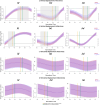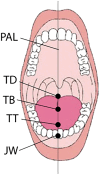Co-speech gestures influence the magnitude and stability of articulatory movements: evidence for coupling-based enhancement
- PMID: 39748052
- PMCID: PMC11695587
- DOI: 10.1038/s41598-024-84097-6
Co-speech gestures influence the magnitude and stability of articulatory movements: evidence for coupling-based enhancement
Abstract
Humans rarely speak without producing co-speech gestures of the hands, head, and other parts of the body. Co-speech gestures are also highly restricted in how they are timed with speech, typically synchronizing with prosodically-prominent syllables. What functional principles underlie this relationship? Here, we examine how the production of co-speech manual gestures influences spatiotemporal patterns of the oral articulators during speech production. We provide novel evidence that words uttered with accompanying co-speech gestures are produced with more extreme tongue and jaw displacement, and that presence of a co-speech gesture contributes to greater temporal stability of oral articulatory movements. This effect-which we term coupling enhancement-differs from stress-based hyperarticulation in that differences in articulatory magnitude are not vowel-specific in their patterning. Speech and gesture synergies therefore constitute an independent variable to consider when modeling the effects of prosodic prominence on articulatory patterns. Our results are consistent with work in language acquisition and speech-motor control suggesting that synchronizing speech to gesture can entrain acoustic prominence.
Keywords: Articulation; Co-speech gestures; Prosody; Speech; Speech-motor coupling.
© 2024. The Author(s).
Conflict of interest statement
Declarations. Competing interests: The authors declare no competing interests. Ethics declarations: This research was granted ethics approval by the Institutional Review Board of Harvard University (Protocol IRB 22-1097).
Figures










Similar articles
-
Interaction in planning movement direction for articulatory gestures and manual actions.Exp Brain Res. 2015 Oct;233(10):2951-9. doi: 10.1007/s00221-015-4365-y. Epub 2015 Jul 1. Exp Brain Res. 2015. PMID: 26126804
-
Articulatory vowel lengthening and coordination at phrasal junctures.Phonetica. 2000 Jan-Mar;57(1):3-16. doi: 10.1159/000028456. Phonetica. 2000. PMID: 10867568
-
The timing of head movements: The role of prosodic heads and edges.J Acoust Soc Am. 2017 Jun;141(6):4727. doi: 10.1121/1.4986649. J Acoust Soc Am. 2017. PMID: 28679274
-
Gestural coordination at prosodic boundaries and its role for prosodic structure and speech planning processes.Philos Trans R Soc Lond B Biol Sci. 2014 Dec 19;369(1658):20130397. doi: 10.1098/rstb.2013.0397. Philos Trans R Soc Lond B Biol Sci. 2014. PMID: 25385775 Free PMC article. Review.
-
From manual gesture to speech: a gradual transition.Neurosci Biobehav Rev. 2006;30(7):949-60. doi: 10.1016/j.neubiorev.2006.02.004. Epub 2006 Apr 18. Neurosci Biobehav Rev. 2006. PMID: 16620983 Review.
Cited by
-
The human voice aligns with whole-body kinetics.Proc Biol Sci. 2025 May;292(2047):20250160. doi: 10.1098/rspb.2025.0160. Epub 2025 May 21. Proc Biol Sci. 2025. PMID: 40393483
References
-
- Sueyoshi, A. & Hardison, D. M. The role of gestures and facial cues in second language listening comprehension. Lang. Learn.55, 661–699 (2005).
-
- Hostetter, A. B. When do gestures communicate? A meta-analysis. Psychol. Bull.137, 297–315 (2011). - PubMed
-
- Bavelas, J., Gerwing, J., Sutton, Ch. & Prevost, D. Gesturing on the telephone: Independent effects of dialogue and visibility. J. Mem. Lang.58, 495–520 (2008).
Publication types
MeSH terms
Grants and funding
LinkOut - more resources
Full Text Sources

